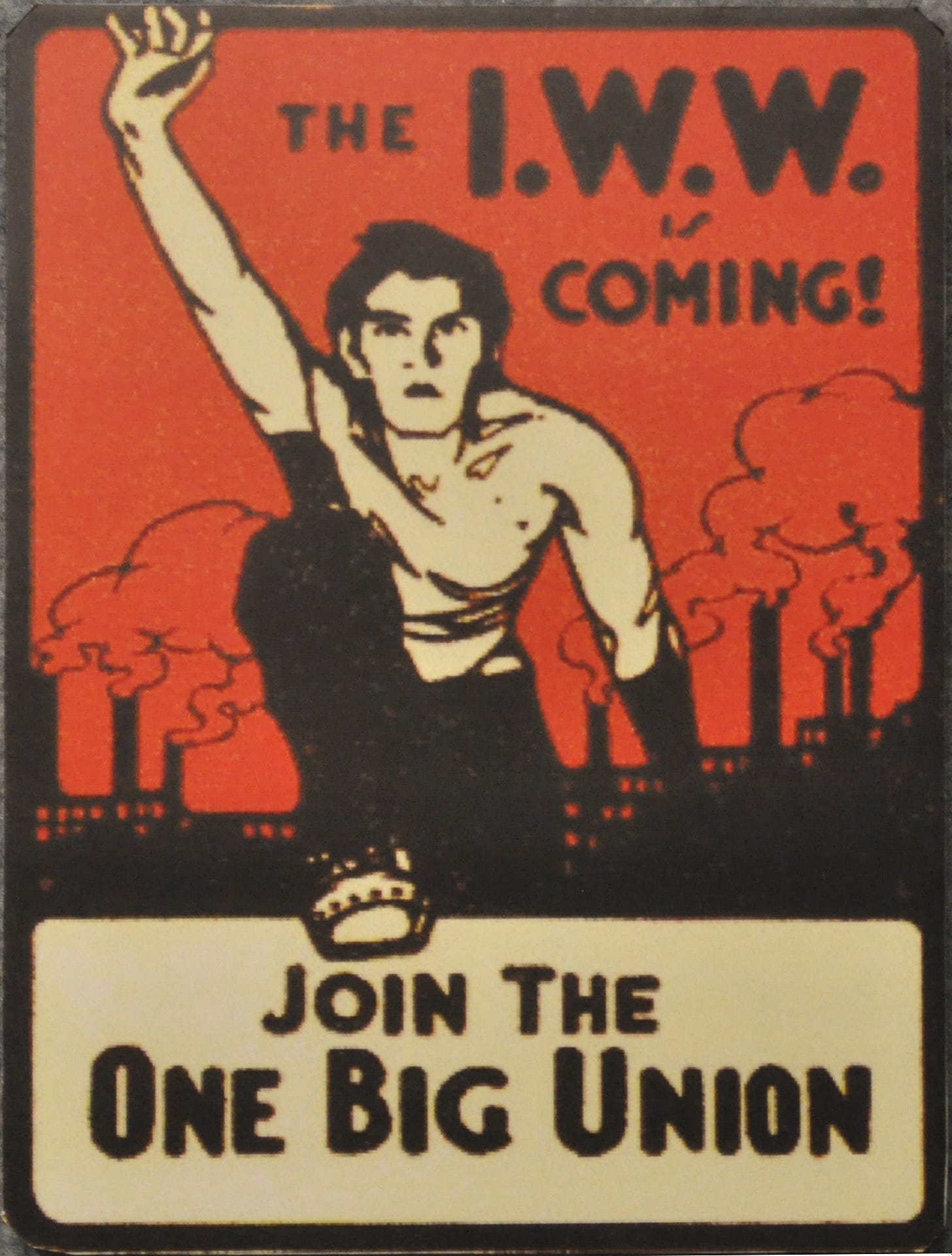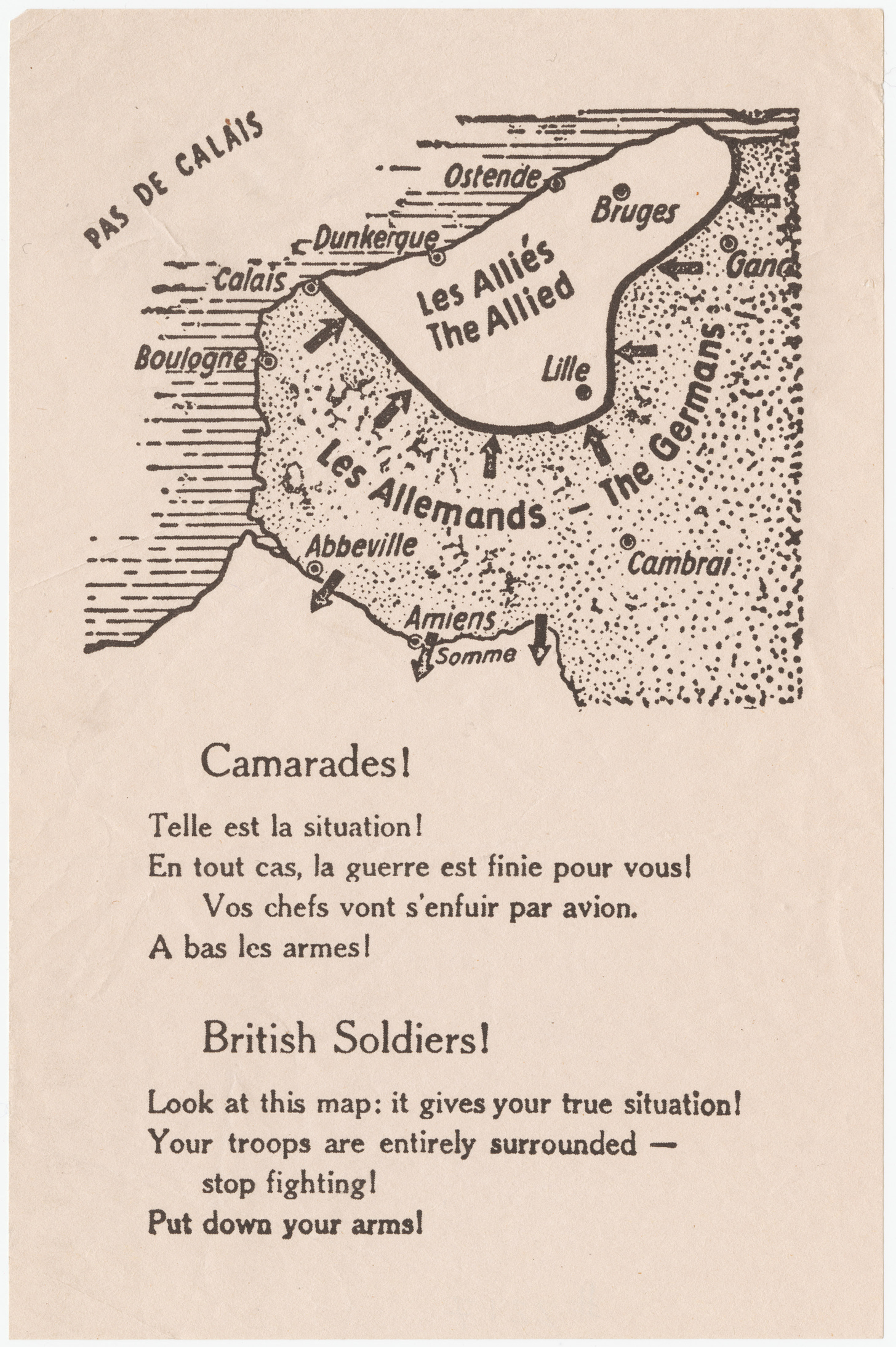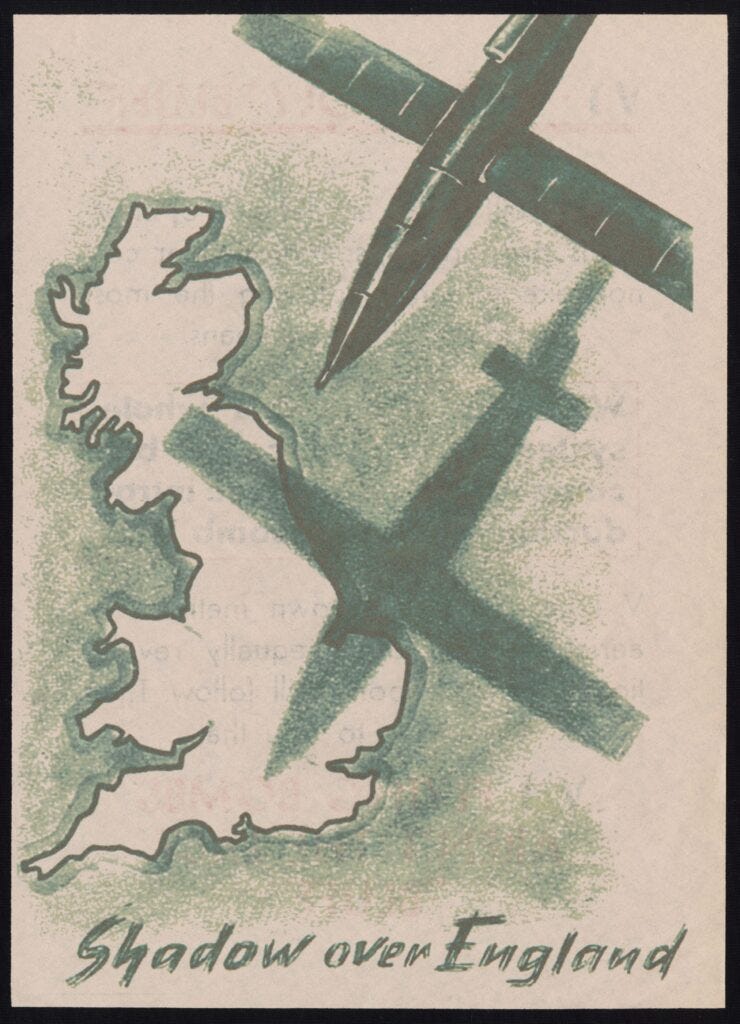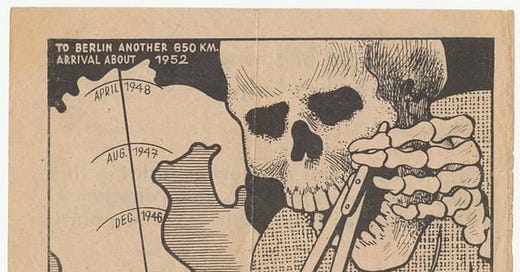Maps in airborne leaflet propaganda during WWII
Aerial pamphlet propaganda was widely used during World War II, and on many occasions maps were featured to influence the narrative on enemy troops and foreign nationals.
When talking about propaganda, usually two media come to people's minds: posters and leaflets. This is not necessarily because of their effectiveness1, but because time has made them iconic. The versatility of the images has allowed their use to persist to represent an era and ideas in illustrated books, documentaries and films.
In the article today, I am compiling some of the pamphlets that used maps as an effective tool to communicate a biased message during World War II. More specifically of airborne leaflets, those that were dropped over enemy territory to influence the morale of the army and the civilian population.
What are airborne leaflets?
The leaflet is a medium that appeared hand in hand with the printing press. Until then, the reproduction of books was limited to manual copies, but with the advent of the printing press, the capability to make easy and cheaper copies appeared. Thanks to this, pages with news, opinions and even doctrines soon began to be printed, which is what we know as pamphlets2. The absence of a cover and the limited number of pages also made the pamphlets easy to transport and distribute, even without a state distribution network.
All these facilities are key to understanding the emergence of persuasive pamphlets. They have been used intensively in multiple asymmetric confrontations during the Modern and Contemporary Ages, as in the case of the Lutheran Reformation, the civil wars in England or the workers' movements in Europe. The dissemination of pamphlets was hand-to-hand, requiring a chain of physical contact to ensure that the copies would not be lost. As a consequence, the outreach was limited, limiting the capability to spread messages in a hostile environment.
But all this changed in the late 19th century.

Technological advances in air transport soon began to play an important role. The invention of the hot air balloon made it possible to fly leaflets through the air over long distances and even across enemy lines. One of the first recorded examples was during the siege of Paris in 1871, when the Prussian Army chartered balloons loaded with leaflets that were dropped in the streets of the city for Parisians to read. These leaflets contained persuasive messages, with which Prussia intended to influence the citizens to rebel against the French government and facilitate the surrender of the city.
Despite its advantages, the balloon had a fundamental problem. Since its operation depended on air currents at different altitudes, it was very difficult to get the leaflets to fall in the desired area, where the target audience of the propaganda was located. It did not take long for the issue to be solved, as the rise of aviation provided the possibility of having manned flights over an area to drop the material in the right place.
This tactic was first used in the war between Italy and the Ottoman Empire in North Africa between 1911 and 1912. Italy was the first country to bomb an enemy territory with aircraft, but it was also the first to drop propaganda leaflets over enemy territory with guided aircraft. This new strategy soon became known by the world's great powers and, during the interwar period, almost every state worked on perfecting it. This allowed that just three days after the outbreak of World War II, on September 4, 1939, the United Kingdom was able to begin Operation Nickel: squadrons 51 and 58 flew over the cities of Kiel, Hamburg, Bremen, and the entire Rhine basin, dropping well over six million leaflets against the Nazi government.
The Siege of Dunkirk (1940)

German air forces dropped this leaflet on Allied troops cornered around Dunkirk, on the border between France and Belgium, in May 1940. The map uses horizontal stripes to identify the sea and dots to demarcate all territory conquered by Germany. It also includes a series of arrows on all fronts, thus generating a sense of constant and inescapable pressure from the German army on the diminishing Allied territory.
The leaflet also included two texts addressed to the Allied soldiers, but each audience with its own message. The message addressed to the French referred to the fact that their leaders had already left the country and that the war was over for them, with Germany expecting them to surrender in the face of the impossibility of victory. On the other hand, the message addressed to the British sought to make the soldiers aware that the situation was complicated and that there was no point in continuing to fight. With this, they were asked to surrender and lay down their arms.
A version of this pamphlet appeared in the film adaptation of this event by Christopher Nolan in 2017.

Shadow Over England (1944)

Shadow Over England was a campaign that accompanied the German bombing raids on the United Kingdom during 1944. All of these leaflets included in one form or another the idea that the new German missiles, the V1, were going to be a continuing threat to all of England. Most of the designs showed cities and factories in flames, but this particular leaflet presents the map of England and a V1 drawing an elongated shadow. The main purpose was to emphasize the fragility of the British anti-aircraft defence system, expecting to terrorize the British population.
Oddly enough, these bombs began to be dropped when the Allies had already landed in Normandy and the German fragility was already plainly apparent. This is why the threat of a German land invasion would not be credible to British citizens, but the Nazis could still keep up the pressure and terror with the threat of destruction with missiles and bombs.
A war on four fronts (1944)

Coinciding with the Normandy landings, the Allies also took the opportunity to launch a series of leaflets for French and German troops. This one in particular was one of those addressed to the German army. It featured a map showing the trapped situation of the Axis forces in 1944. The Soviet Union had been progressing from the east front, while the United States and the United Kingdom had been making some progress through Italy for almost a year. From this moment, Allied troops will start advancing from the north and, at the same time, the bombings and pressure will also increase on the home front.
The back of the pamphlet details this idea, with a slogan that was intended to demoralize German soldiers into doubting the cause and deserting: Disaster in the East. Disaster at home. Disaster in the south. And now the Allies land in the west. The western front is open.
Speaking of timetables (1944)
![r/MapPorn - German propaganda leaflet mocking the progress of allied forces in southern Italy, 1944. [735×1024] r/MapPorn - German propaganda leaflet mocking the progress of allied forces in southern Italy, 1944. [735×1024]](https://substackcdn.com/image/fetch/w_1456,c_limit,f_auto,q_auto:good,fl_progressive:steep/https%3A%2F%2Fsubstack-post-media.s3.amazonaws.com%2Fpublic%2Fimages%2Feb63bcf2-10c0-42f8-be2e-3a48a642d6da_640x891.jpeg)
Despite major setbacks, Nazi Germany maintained its pressure on all fronts. This example is a leaflet dropped on Allied troops in southern Italy, questioning the slow progress the southern offensive was making. As the map describes, they had taken Salerno in September 1943, but in eight months they had barely managed to advance 123 kilometres. Extrapolating that speed, it would not be until 1952 that the Allied troops would be able to reach Berlin.
With these simplistic calculations, German propaganda sought to induce doubt among American soldiers, to the point of asking whether it was really worth fighting for so many years to come. This pamphlet alone may seem naive, but it was part of a larger strategy that, among other things, included radio programs starring American women. Homesickness was promoted by talking about all the things the soldiers were missing out on.
Will Japan Be Next? (1945)

On the Pacific front, such leaflets were also used extensively. This particular one was dropped on Japan after the capture of Okinawa in April 1945. The map clearly shows the US advances across the Pacific and how much of Indonesia, the Philippines, and multiple Pacific islands had already been liberated. It is the letters on the red poster that raise the big question: will Japan be next?
It is very difficult to measure the weight of the various propaganda measures, but multiple statements from captured Japanese soldiers lead one to believe that the American leaflets had very little effect on the morale of the Japanese army. Much of this may have been because the propaganda was designed throughout most of the war by Americans, who were completely unfamiliar with Japanese society and its way of looking at the world.
Truly effective propaganda is that which manages to use all available means effectively, so it is not really appropriate to speak of some means being more effective than others.
The first pamphlets appeared in England during the Middle Ages, although their popularization and widespread use did not come until the invention of the printing press.





I absolutely love your substack 💚